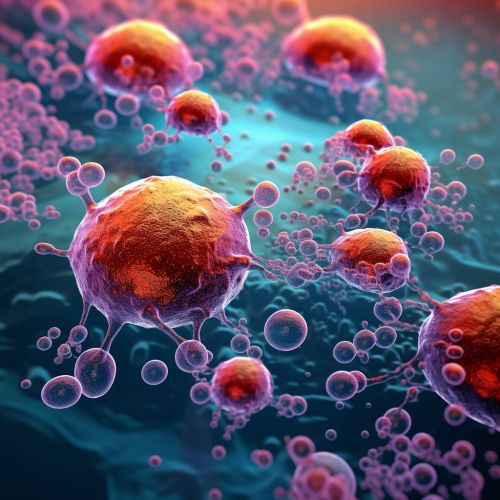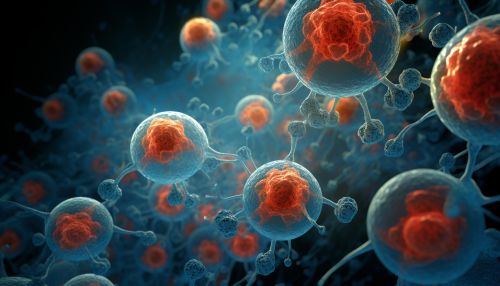Apoptosis
Introduction
Apoptosis, also known as programmed cell death (PCD), is a biological process that results in the self-destruction of cells in multicellular organisms. It is a vital component of various processes including normal cell turnover, proper development and functioning of the immune system, hormone-dependent atrophy, embryonic development and chemical-induced cell death read more. Apoptosis can occur when a cell is damaged beyond repair, infected with a virus, or undergoing stress conditions.
Biochemical Events
Apoptosis is a complex process that involves a series of biochemical events leading to a characteristic cell morphology and death. These changes include blebbing, cell shrinkage, nuclear fragmentation, chromatin condensation, chromosomal DNA fragmentation, and global mRNA decay. The process of apoptosis is controlled by a diverse range of cell signals, which may originate either extracellularly (extrinsic inducers) or intracellularly (intrinsic inducers).


Extrinsic Pathway
The extrinsic pathway of apoptosis is initiated by the binding of a death ligand to a death receptor. Death ligands are members of the tumor necrosis factor (TNF) family of proteins, and include TNF-α, Fas ligand, and TNF-related apoptosis-inducing ligand (TRAIL). The death receptor family includes Fas receptor, TNF receptor 1 (TNFR1), and death receptors 4 and 5 (DR4 and DR5). Upon ligand binding, these receptors form a death-inducing signaling complex (DISC), which contains the adaptor protein FADD and procaspase-8. Procaspase-8 is then cleaved to its active form, caspase-8, which initiates a caspase cascade resulting in apoptosis.
Intrinsic Pathway
The intrinsic pathway is initiated by non-receptor stimuli, such as radiation, toxin, hypoxia, hyperthermia, viral infections, and free radicals. These stimuli cause changes in the inner mitochondrial membrane that result in an opening of the mitochondrial permeability transition pore, loss of the mitochondrial transmembrane potential, and release of two main groups of normally sequestered pro-apoptotic proteins from the intermembrane space into the cytosol. The first group, the apoptogenic factors, includes cytochrome c, Smac/DIABLO, and Omi/HtrA2. The second group, the caspase activators, includes procaspase-9 and APAF-1. These proteins trigger the activation of caspase-9 and subsequently the executioner caspases-3, -6, and -7, leading to apoptosis.
Role in Disease
Apoptosis plays a crucial role in maintaining homeostasis and preventing disease. However, dysregulation of apoptosis can lead to pathogenesis of a wide range of diseases, including cancer, autoimmune diseases, and neurodegenerative disorders. In cancer, cells evade apoptosis, leading to uncontrolled cell proliferation. In autoimmune diseases, increased apoptosis can lead to the presentation of self-antigens, triggering an immune response against the body's own cells. In neurodegenerative disorders, excessive apoptosis results in the loss of irreplaceable neurons.
Therapeutic Applications
Understanding the mechanisms of apoptosis has led to the development of novel treatments for diseases such as cancer. Therapies that can induce apoptosis in cancer cells include chemotherapy, radiation therapy, and targeted therapies that specifically trigger the apoptotic machinery. Conversely, in diseases characterized by excessive apoptosis, strategies to inhibit the apoptotic process are being explored.
